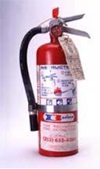PORTABLE HOME FIRE EXTINGUISHERS
When used properly, a portable fire extinguisher can save lives and property by extinguishing a small fire or containing it until the Fire Department arrives. Individuals must know how to use the extinguisher - the easiest way is to remember the "PASS" procedure: P ull pin, A im at the base of the fire, S queeze the lever, and S weep from side-to-side.
Recommendations about extinguishers:
Must be within easy reach, in working order and fully charged.
Must be installed in plain view of an escape route.
Must match the type of fire being fought. Extinguishers that contain water are unsuitable for use on grease and electrical fires.
ABC extinguishers are recommended for use on the most common home fires.
Must be large enough to put out the fire. Many portable extinguishers discharge in as few as 10 seconds.
2A: 10B:C or larger size is recommended for home use.
Have extinguishers tested and recharged after each use and annually by a licensed service company.
Always call “9-1-1" before attempting to extinguish a fire; and make sure everyone has left or is in the process of leaving the building. Be sure the Fire Department inspects the fire site, even if the fire appears to have been extinguished before they arrive.
EXIT DRILLS IN THE HOME
In the event of fire, get out fast! Families should pre-plan two ways out of every room, especially bedrooms. Make sure everyone can unlock all locks and open all windows and doors. The whole family should practice the escape plan at least twice a year. In a two-story house, consider purchasing a folding escape ladder for bedrooms on the second floor.
Practice staying low to the floor. During a fire, to avoid breathing dangerous smoke, crawl under smoke.
Before opening any interior door, feel it with the back of the hand; if the door is hot or blocked with fire or smoke, use the second way out.
Choose a meeting place outdoors where everyone will gather. Once outside, stay out! Call “9-1-1" to report a fire from a neighbor’s phone.
CHILDREN AND MATCHES
Matches and lighters are deadly in the hands of a child. Use child-resistant lighters and store all matches and lighters high where youth cannot reach them, preferably in a locked cabinet.
Teach children from an early age that matches and lighters are tools for adults, not toys. Teach them that if they find matches or a lighter, they should tell an adult immediately.
Some children may appear fascinated by fire. If this behavior is noticed, call the Fire Prevention Bureau for an appointment. Fire inspectors have special training in educating juveniles on the hazards of fire.
CARBON MONOXIDE DETECTORS
Carbon monoxide (CO) poisoning claims more than 200 lives each year in America, and sends another 10,000 people to the hospital for treatment.
Install at least one UL-listed carbon monoxide alarm near all sleeping areas and outside individual bedrooms.
How to react to a carbon monoxide alarm depends on whether anyone is feeling ill or not:
If no one is feeling ill:
- Silence the alarm
- Turn off all appliances and sources of combustion (furnace and fireplace)
- Ventilate the house with fresh air by opening doors and windows
- Call a qualified professional to investigate the source of the possible carbon monoxide build-up (gas company or Fire Department)
If illness is suspected or a factor:
- Evacuate all occupants immediately
- Determine how many occupants are ill and their symptoms
- Call “9-1-1"
- Do not re-enter the home without the approval of a Fire Department representative
- Call a qualified professional to repair the source of the carbon monoxide.
